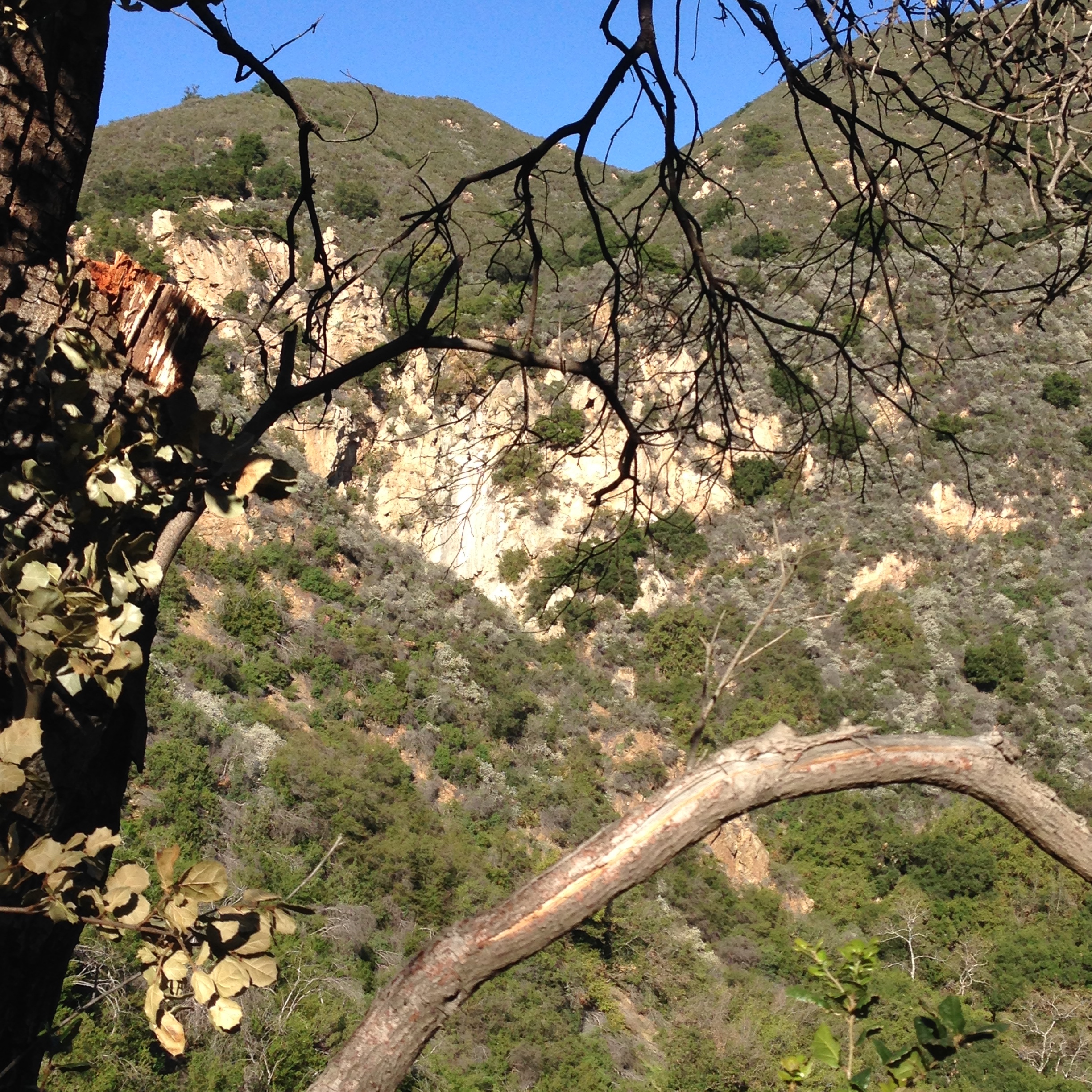Cold Spring Trail - West Fork - Los Padres National Forest
Trail Distance 1.50 Miles
The trail follows a creek through a narrow canyon, and enters a large semicircular valley (with a view of Tangerine Falls). The trail then diverges from the creek and climbs up to Gibraltar Road. 200 foot high Tangerine Falls is in a canyon to the north of the trail. Directions: Take Cold Springs Road, turn right on Mountain Drive, go ½ mile and park near the creek crossing (this is the East Fork trailhead). West fork of the Cold Springs trail takes off from The East Fork trail 1/2 mile from bottom trailhead near a wooden bench overlooking the creek.
Unlike most of the trails, which run in a north-south direction, the West Fork follows an east-west course. The reason for this can be found in the geology of this particular area. Matilija Sandstone lies on the north side of the trail; Coldwater Sandstone is on the south side. Sandwiched in-between is a layer known as Cozy Dell Shale. High along the crest the shale forms impressive saddles. As it dips across the ocean side of the Santa Ynez Mountains, it forms what are known as strike canyons, which flow at right angles to the main canyons. The West Fork Trail winds its way up the largest of these strike canyons.
To reach the West Fork trail, hike up the East Fork trail a quarter mile to a very pretty waterfall with a nearby bench. Cross the creek and look for the trail behind a series of large boulders. The trail climbs slowly, undulating up the left side of the narrow canyon. In the afternoon this section is shade-covered, making the hike pleasant on hot summer days.
The path wanders through dense green canyon vegetation for three quarters of a mile before opening into the valley. Slightly to right of center is a magnificent 200 foot high waterfall. This is Tangerine Falls. The side trail leading up to it is not too far beyond the viewpoint.
Just past the turnoff for Tangerine Falls, the main West Fork trail climbs a bit then crosses to the right side of the canyon. There is often quite a bit of poison oak in this area so I carry a pair of clippers just in case I need to trim some of it back. A hundred yards above here the trail crosses the creekbed and begins a series of switchbacks which take you directly uphill for several hundred feet until you are no longer in the canyon but high up on the hillside.
Once you are at the end of the switchbacks, the trail climbs steeply for several hundred yards up through a very pretty tunnel of hillside chaparral and crosses two small wooden bridges which are very cute (you’ll know what I mean if you’ve seen them). At this point the trail opens out into the full sunlight and on a hot day it can be very tough hiking up to the road.
Just beyond the second bridge the trail turns north and climbs across a small knoll. The views back down the canyon are very pretty and in the “vee” formed by the lower hillsides you can see the Carpinteria valley. Above the views are equally nice. Near the top of the ridge you’ll notice a large rock formation. This is Cold Springs Dome, a popular rock climbing area.
As you round the knoll the trail turns back to the left, levels a bit, and then continues straight up to Gibraltar Road. You’ll know you are nearing the end of the trail by the hundreds of small pieces of glass which begin to appear on the ground. The steep hillside near the hairpin turn has been used in past years for target practice. Thanks to the efforts of the Sierra Club and other trail users, the Forest Service has closed this and other areas to casual “plinking,” making it a much safer area for hiking.
If you would like to reach Rattlesnake Canyon you can do so by walking up the road for a mile to the connector trail leading down into it.
Ray Ford - http://www.sboutdoors.com/cold-spring-west-fork.html
Trail Details
- Trail #: 27W16
- Wilderness Area: Non Wilderness Area
- County: Santa Barbara County
- Ranger District: Santa Barbara Ranger District
- Trail-head Latitude: 34.46758
- Trail-head Longitude: -119.67001
- Trail Condition: Good - Trail is easy to follow and is in good shape
- Topo Maps:
Activities & Features: - Day Hiking
- Mountain Biking
Trail Stats
- Total Elevation Gain: + 411 feet.
- Total Elevation Loss: - 1468 feet.
- Overall Average Slope Gain: + 16 %.
- Overall Average Slope Loss: - 24 %.
- Kilometers: (km)
- Meters: (m)
- Miles: (mi)
- Feet: (ft)
- Average Slope: (%)
Survey Photos:

Lindsay Fisher - 03-02-2015
Los Padres Forest Association - 02-07-2017
Los Padres Forest Association - 02-07-2017
Los Padres Forest Association - 02-07-2017
Los Padres Forest Association - 02-07-2017
Los Padres Forest Association - 02-28-2017
Los Padres Forest Association - 02-28-2017
Los Padres Forest Association - 02-28-2017



 Use Marker Groups
Use Marker Groups Cold Spring Trail - West Fork Survey - 10-14-2018 - by Los Padres Forest Assocation
Cold Spring Trail - West Fork Survey - 10-14-2018 - by Los Padres Forest Assocation